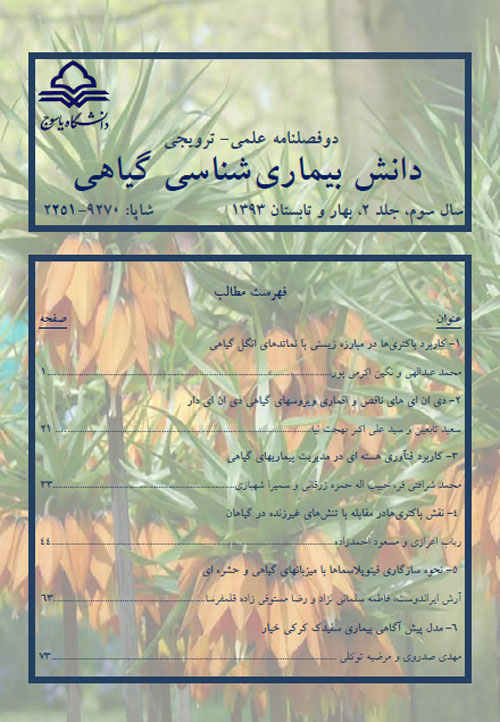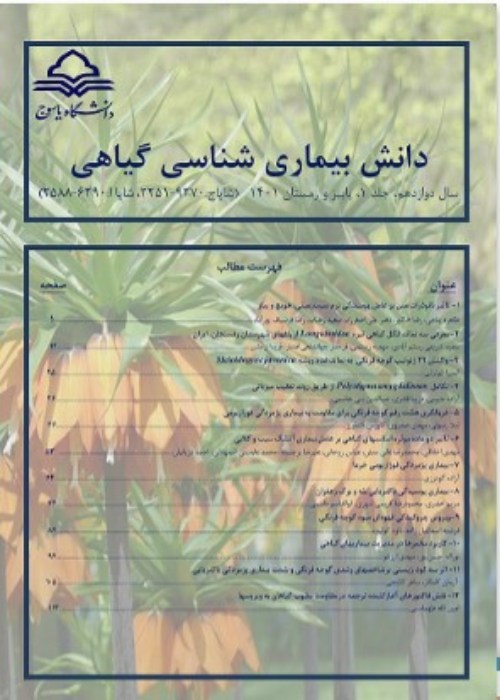فهرست مطالب

نشریه دانش بیماری شناسی گیاهی
سال سوم شماره 2 (پیاپی 6، بهار و تابستان1393)
- تاریخ انتشار: 1393/06/18
- تعداد عناوین: 6
-
-
صفحات 1-20نماتدهای انگل گیاهی در بسیاری از مناطق جهان موجب خسارت اقتصادی به انواع محصولات کشاورزی می شوند. بعضی از این نماتدها در خاک تحت تاثیرباکتری های متعارض قرار می گیرند و همین موضوع امکان استفاده از این باکتری ها را در مبارزه زیستی با آن ها فراهم کرده است. باکتری ها به شیوه های مختلفی از جمله سرکوب مستقیم نماتدها، افزایش رشد گیاه، افزایش جمعیت در فراریشه و فعالیت تعارضی، بر نماتدها اثر می گذارند. به طور کلی، با در نظر گرفتن نحوه تاثیر باکتری ها بر نماتدها، آن ها به گروه های انگل کننده، تولیدکننده زهرابه، مواد پادزیستی و آنزیم ها و افزایش دهنده ی رشد گیاهان تقسیم بندی شده اند. بر اساس پژوهش های انجام شده این باکتری ها در گروه های نماتدخوار، فرصت طلب، حاضر در فراریشه، درون رست، همزیست با نماتدهای بیمارگر حشرات و تشکیل دهنده ی پروتئین های کریستالی قرار داده شده اند. همچنین امکان کاربرد تلفیقی باکتری ها با بعضی ریزجانداران متعارض دیگر در مبارزه زیستی با نماتدهای انگل گیاهی نیز به اثبات رسیده است.
کلیدواژگان: باکتری، متعارض، نماتد، Pasteuria، Meloidogyne -
صفحات 21-32در گیاهان آلوده به ویروس های دی ان ای دار، به طور معمول علاوه بر دی ان ای ژنومی، انواع مختلفی از نسخه های دی ان ای کوچک تر از ژنوم نیز حضور دارند که از ژنوم ویروس مشتق شده و یا دارای توالی های غیر از ژنوم ویروس هستند. بعضی از این دی ان ای ها که اثر قابل توجهی بر چرخه ی ویروس و نیز بروز و پیشرفت بیماری و نشانه ها ندارند، را دی ان ای های ناقص می گویند. تعداد دیگری از آن ها که سبب کاهش تجمع دی ان ای ژنومی ویروس و در نتیجه کاهش نشانه ها و بهبودی می گردند، دی ان ای های ناقص مداخله گر نامیده شده اند. تعدادی از آن-ها نیز القاکننده ی نشانه های بیماری هستند که تحت عنوان دی ان ای های اقماری شناخته می شوند. تمام این اجزا برای همانندسازی، کپسیدپوشی و حرکت در گیاه به ویروس اصلی وابسته هستند. دی ان ای های اقماری هرچند که فاقد همانندی مشخصی با ژنوم ویروس هستند اما مسئول القای نشانه های بیماری هستند. در حالی که دی ان ا های ناقص و ناقص مداخله گر همانندی زیادی با ژنوم ویروس دارند، تنها دی ان ای های ناقص مداخله گر توانایی دخالت در فرآیندهای تکثیر، بروز و توسعه ی نشانه های بیماری را دارا هستند. در این مقاله انواع و خصوصیات این قبیل دی ان ای ها و نحوه انتقال آن ها شرح داده شده است.
کلیدواژگان: بیماری، ویروس، Geminiviridae، Nanoviridae، Caulimoviridae -
صفحات 33-43یکی از ارکان توسعه پایدار هر کشور در بخش کشاورزی تولید مواد غذایی مناسب و تامین امنیت آن است. در حال حاضر بیش از 800 میلیون نفر عموما در آفریقا وآسیا از گرسنگی رنج می برند و کشاورزی مبنع اصلی برای تهیه غذای این افراد است. یکی از کاربردهای فنآوری هسته ای، استفاده از آن در کاهش خسارت آفات و بیماری های گیاهی است. روش های هسته ای در بیمار ی شناسی گیاهی به طور کلی در 3 گروه ردیابی، ایجاد جهش و پرتوتابی محصولات برای القای مقاومت در گیاهان و کاهش یا نابودی عوامل بیماری زا مورد استفاده قرار می گیرند. امروزه یکی از جدیدترین مباحثی که مورد توجه قرارگرفته، استفاده از اشعه گاما در القای مقاومت در برابر تنش-های محیطی و بیمارگرها و بهبود خصوصیات رشدی گیاهان است. استفاده از این توان بویژه برای مدیریت بیماری-های بذر و گیاهچه که بخش اعظم خسارت را در اولین هفته های رشد گیاهچه وارد می آورند از اهمیت بالایی برخوردار است.
کلیدواژگان: القای مقاومت، بیماری، پرتوتابی، Trichoderma، Rhizoctinia -
صفحات 44-62
تنش های غیر زنده در سراسر دنیا یکی از عوامل محدودکننده کشاورزی محسوب می شوند. به طور میانگین بسته به نوع گیاه، تنش های غیرزنده سبب کاهش 50 تا 82 درصدی عملکرد گیاهان می شوند. تنش های غیرزنده شامل دمای نامناسب، خشکی، شوری، غرقاب، یخبندان، اشعه ی فرابنفش، سمیت مواد معدنی مانند فلزات سنگین، کمبودهای غذایی، اسیدیته نامناسب، آلاینده های هوا و آسیب های مکانیکی می باشند. تنش های غیرزنده منجر به سمیت متابولیکی، گسستگی غشای سلولی، کاهش فتوسنتز، کاهش جذب بعضی از عناصر غذایی، تغییر سطوح هورمون های گیاهی و در نهایت کاهش رشد و عملکرد گیاهان می شوند. بنابراین کاهش اثر این تنش ها، مهم و ضروری است. باکتری های فراریشه افزایش دهنده رشد گیاهان نقش مهمی در مدیریت عوامل بیماری زای زنده و توان بالایی در کاهش تنش های غیرزنده در گیاهان دارند.
کلیدواژگان: باکتری، تنش، خشکی، شوری، Pseudomonas -
صفحه 57فیتوپلاسماها بیمارگرهای گیاهی هستند که در آوندهای آبکش مستقر می شوند و تکثیر می یابند. آن ها با حشره های تغذیه کننده از شیره ی آوندی، در بین گیاهان مختلف انتقال می یابند. فیتوپلاسماها زیست شناسی و چرخه ی زندگی متفاوتی نسبت به باکتری ها دارند، زیرا آن ها توانایی بقا در میزبان هایی از 2 سلسله ی کاملا متفاوت یعنی گیاهان و جانوران (حشره ها) را دارند. آن ها میزبان هایشان را به صورت فراگیر آلوده می کنند. فیتوپلاسماها برای سازگاری با میزبان های مختلف از سازوکارهایی مانند تغییر در میزان بیان ژن ها، ایجاد تنوع و نوترکیبی در دی ان ای های خارج کروموزومی و نیز واحدهای بالقوه متحرک، تولید عمل گرها و خاموشی مسیرهای پیام دهی دفاعی استفاده می کنند و با موفقیت در آن ها استقرار و تکثیر یافته، تولید بیماری می کنند. شناسایی این سازوکار ها گامی مهم برای برنامه ریزی مدیریت موفق این بیمارگرها است.
کلیدواژگان: بیماری، زنجرک، فیتوپلاسما، گیاه، زردی -
صفحات 67-81بیماری سفیدک کرکی، ناشی از Pseudoperonospora cubensis، مهمترین بیماری خیار در مناطق مرطوب و گلخانه های تولید آن در کشور است، که خسارت آن تا 100درصد محصول می رسد. از آنجا که برای مبارزه با این بیماری روی ارقام حساس تحت کشت، اغلب از مبارزه شیمیایی استفاده می شود، با برقراری برنامه پیش آگاهی آن براساس بررسی جمعیت بیمارگر در مزرعه و اندازه گیری دما و رطوبت نسبی هوا در مزرعه و گلخانه می توان زمان ظهور بیماری را پیش بینی نمود و با یک سمپاشی به موقع با یکی از سموم محفاظتی و یا جذبی مناسب از بروز و شیوع بیماری پیشگیری نمود و خطر باقیماندن سم در این محصول، که به صورت تازه مصرف می شود، هزینه های تولید و قیمت محصول را کاهش داد.
کلیدواژگان: خیار، دما، رطوبت، سفیدک کرکی، متالاکسیل
-
Pages 1-20Plant-parasitic nematodes are one of the most important pests worldwide and cause considerable economic loss to many of agricultural products. Some of soil inhabited nematodes are affected by some of antagonistic bacteria, so they can be used in biological control. Nematodes can be affected by bacteria in different ways such as direct suppression, promotion of plant growth, and facilitation of rhizosphere colonization. In overall, regarding to effect of soil inhabits bacteria on nematodes; they can be classified as toxin producing, antibiotic producing and enzyme producing as well as plant growth promoting groups. Based on the recent researches, bacteria are divided to six groups including: parasitic bacteria (nematophagous bacteria), opportunistic parasitic bacteria, rhizobacteria, endophytic bacteria, symbionts of entomopathogenic nematodes and cry protein-forming bacteria. Combination of bacteria with some other antagonistic microorganisms was successful in control of plant parasitic nematodes.Keywords: Bacteria, Antagonist, Nematode, Pasteuria, Meloidogyne
-
Pages 21-32In addition to the full-length viral DNA genome, various types of smaller specific DNA molecules have been isolated from plants infected by DNA viruses. These DNAs are usually derived from viral genomes by different ways or have non-viral genome sequences. Some of these DNA have no significant effect on the virus cycle and on the incidence and progression of the disease, while some of them inducing the viral disease symptoms. These components that are known as satellite, defective and defective interfering DNAs, depend on helper viruses for replication, encapsidation and movement in plants. Satellites have no significant homology with the helper virus genome. However, they are required for inducing disease symptoms. While defective and defective interfering DNAs exhibit high homology with the genome of helper viruses, only defective interfering DNAs have ability to interfere with virus replication and with disease symptom induction and development. In this paper, the characteristics of these subviral DNAs and the possible mechanisms by which they are generated and transmitted in virus infected plants are discussed.Keywords: Disease, Virus, Geminiviridae, Nanoviridae, Caulimoviridae
-
Pages 33-43Food production and food security is an essential precursor to sustainable development in agriculture. Currently, more than 800 million people, generally in Africa and Asia, suffer from hunger and agriculture is considered as the main source of food for them. One of the application of nuclear technology is reducing the damages of plant pest and diseases. The application of nuclear techniques in plant pathology can be grouped in three categories including disease tracing, mutagenesis induction and radiation of crops to induce resistance and destruction of pathogens. As a new method to induce defense responses to biotic and abiotic stresses, nowadays, gamma radiation is used to improve the growth in the way to induce the plant resistance to environmental tensions and plant pathogens as well. Use of this potential, especially in management of seed and seedling diseases is very important to reduce a big portion of crop losses caused by plant pathogens in the first weeks of seedling growth.Keywords: Induce Resistance, Disease, Radiation, Trichoderma, Rhizoctinia
-
Pages 44-62
Abiotic stresses are major environmental factors that affect agricultural productivity worldwide. Depending on the crop, the yield losses associated with abiotic stresses can reach 50 to 82 percent. Extreme temperatures, drought, salinity, flooding, freezing, ultraviolet light, heavy metals, nutrient deficiency, unsuitable pH, air pollutants and mechanical damage are the most basic stressors. Because biotic stresses cause metabolic toxicity, membrane degradation, reduction of photosynthesis, decrease of nutrient uptake, changes in levels of phytohormones and ultimately affect the plant growth and its productivity, therefore reducing the effect of these stresses, is essential. Plant growth promoting rhizobacteria play an important role in plant disease management and have a high potential in alleviation the abiotic stresses.
Keywords: Bacterium, Stress, Drought, Salinity, Pseudomonas -
Page 57Phytoplasmas are some plant pathogens that establish and propagate in plant phloems. They have transmitted by sucking insects. Phytoplasmas have a different lifecycle as compare to bacterial pathogens. They have ability to infect different hosts two different kingdoms, planta and animalia (insects). They systemically infect their hosts. Phytoplasmas have various approaches for adaptation to their hosts. Some of adaptation mechanisms include: changes in the level of gene expression, variation and recombination in extrachromosomal DNA and potential mobile units, production of effectors and suppression of defense signaling pathways. These approaches enable them to establish, propagate and infect various hosts. Recognizing these strategies would be a major step on the effective management of these pathogens.Keywords: Disease, Leafhopper, Phytoplasma, Plant, Yellowing
-
Pages 67-81Downy mildew, caused by Pseudoperonospora cubensis, is the most important disease of cucumber production in humid areas and greenhouses in Iran. The yield loss of cucumber due to downy mildew may reach to 100%. Because the chemical control is the main method of disease control, especially in susceptible cultivars, establishing a forecasting program which is based on estimation of pathogen population, recording the temperature and relative humidity of field and greenhouse, can reduce the risk of disease epidemic. So by proper application of a protective or systemic fungicide can reduce the disease incidence, production costs and the most important, the amount of fungicide residue.Keywords: Cucumber, Temperature, Humidity, Downy mildew, Metalaxyl


